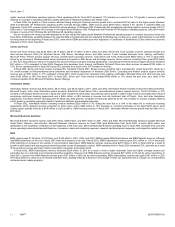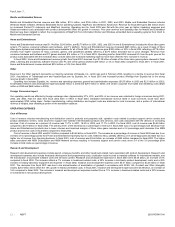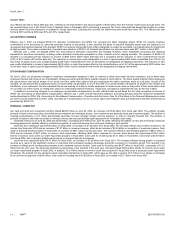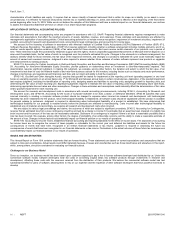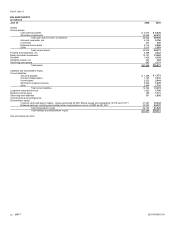Microsoft 2003 Annual Report Download - page 25
Download and view the complete annual report
Please find page 25 of the 2003 Microsoft annual report below. You can navigate through the pages in the report by either clicking on the pages listed below, or by using the keyword search tool below to find specific information within the annual report.Part II, Item 7,
MSFT 2003 FORM 10-K
12 /
Mobile and Embedded Devices
Mobile and Embedded Devices revenue was $86 million, $112 million, and $156 million in 2001, 2002, and 2003. Mobile and Embedded Devices includes
Windows Mobile software, Windows Embedded device operating systems, MapPoint, and Windows Automotive. Revenue for fiscal 2003 grew $44 million driven
by increased Pocket PC shipments and MapPoint licensing. Operating loss for fiscal 2003 was flat with the prior year as higher marketing expenses and
headcount-related costs associated with product development offset the growth in revenue. Prior year revenue and operating loss for Mobile and Embedded
Devices have been restated to reflect the reorganizations of MapPoint from Information Worker and Windows embedded device operating systems from Client to
Mobile and Embedded Devices.
Home and Entertainment
Home and Entertainment revenue was $1.14 billion, $2.45 billion, and $2.75 billion in 2001, 2002, and 2003. Home & Entertainment includes the Xbox video game
system, PC games, consumer software and hardware, and TV platform. Home and Entertainment revenue increased $295 million, as a result of sales of Xbox
video game systems and related games which were available for all of fiscal 2003. Xbox revenue grew $309 million or 23% in fiscal 2003 reflecting a $779 million
increase from higher volumes for Xbox consoles, games, and peripherals partially offset by a $470 million decrease due to price changes. Revenue from
consumer hardware and software and PC games declined $14 million or 1% in fiscal 2003. Operating loss for fiscal 2003 increased 6% from the prior year as the
product costs associated with the increased Xbox console sales and increased marketing expense more than offset the 12% increase in revenue.
In fiscal 2002, Home and Entertainment revenue growth from fiscal 2001 stemmed from $1.35 billion of sales of the Xbox video game system released in fiscal
2002. Learning and productivity software revenue and PC and online games declined $39 million or 3% in fiscal 2002 compared to fiscal 2001. In fiscal 2001,
Home and Entertainment revenue declined $214 million or 16% from fiscal 2002.
Other
Revenue in the Other segment represents our majority ownership of Expedia, Inc., which was sold in February 2002, resulting in a decline in revenue from fiscal
2001. Acquisitions of Travelscape.com and VacationSpot.com by Expedia, Inc. in fiscal 2001 and increased product offerings from Expedia led to the strong
revenue growth in fiscal 2001.
Operating loss includes Expedia, Inc. revenue and operating expenses, general and administrative expenses ($1.55 billion in 2002 and $2.10 billion in 2003),
broad-based research and development expenses ($202 million in 2002 and $210 million in 2003), and certain corporate level sales and marketing costs ($526
million in 2002 and $688 million in 2003).
Foreign Currencies Impact
Our operating results are affected by foreign exchange rates. Approximately 27%, 25%, and 28% of our revenue was collected in foreign currencies during 2001,
2002, and 2003. Had the rates from fiscal 2002 been in effect in fiscal 2003, translated international revenue billed in local currencies would have been
approximately $700 million lower. Certain manufacturing, selling distribution and support costs are disbursed in local currencies, and a portion of international
revenue is hedged, thus offsetting a portion of the translation exposure.
OPERATING EXPENSES
Cost of Revenue
Cost of revenue includes manufacturing and distribution costs for products and programs sold, operation costs related to product support service centers and
product distribution centers, costs incurred to support and maintain Internet-based products and services, and costs associated with the delivery of consulting
services. Cost of revenue as a percent of revenue was 13.7% in 2001, 18.3% in 2002, and 17.7% in 2003. For fiscal 2003, cost of revenue was $5.69 billion
compared to $5.19 billion in fiscal 2002. The primary driver of the decrease as a percentage of revenue in fiscal 2003 was a 0.2 percentage point decrease from
Home and Entertainment products due to lower volumes and improved margins of Xbox video game consoles and a 0.4 percentage point decrease from MSN
product and service costs in fiscal 2003 compared to fiscal 2002.
Cost of revenue in fiscal 2002 was $5.19 billion compared to $3.46 billion in fiscal 2001. The increase as a percentage of revenue in fiscal 2002 was due to an
increase of 5.3 percentage points from Home and Entertainment primarily due to costs related to Xbox, partially offset by a 0.7 percentage point decrease due to a
higher mix of revenue from licensing business. In fiscal 2001, cost of revenue was $3.46 billion, an increase of $453 million compared to fiscal 2000. The higher
sales associated with MSN Subscription and MSN Network services resulting in increased support and service costs drove 0.4 of the 0.6 percentage point
increase in total costs as a percentage of revenue.
Research and Development
Research and development expenses include payroll, employee benefits, and other headcount-related costs associated with product development. Research and
development expenses also include third-party development and programming costs, localization costs incurred to translate software for international markets, and
the amortization of purchased software code and services content. Research and development expenses for fiscal 2003 were $4.66 billion, an increase of 8%
compared to fiscal 2002. The increase reflects a 7% increase in headcount-related costs, a 25% increase in third-party product development costs, and a 29%
increase in testing laboratory equipment and expense. In fiscal 2002, research and development expenses were $4.31 billion compared to $4.38 billion in fiscal
2001. The decrease from fiscal 2001 was due to the discontinuation of amortization of goodwill in accordance with SFAS 142, Goodwill and Other Intangible
Assets, $272 million which offset the 15% growth in headcount-related costs. In fiscal 2001, research and development expenses were $4.38 billion, an increase of
16% compared to fiscal 2000. The increase in research and development expenses resulted from a 11% increase in headcount-related costs and a 23% increase
in investments in new product development.











